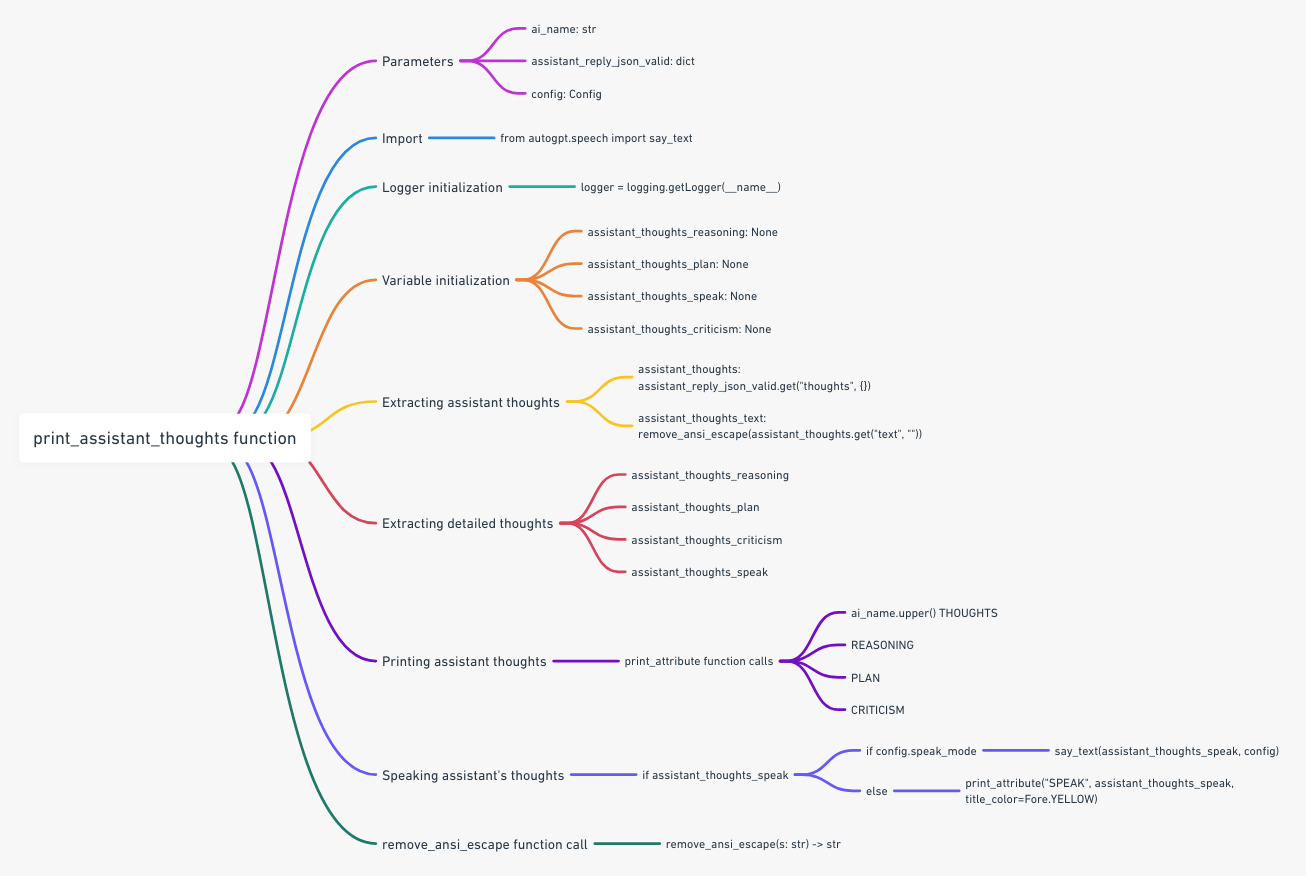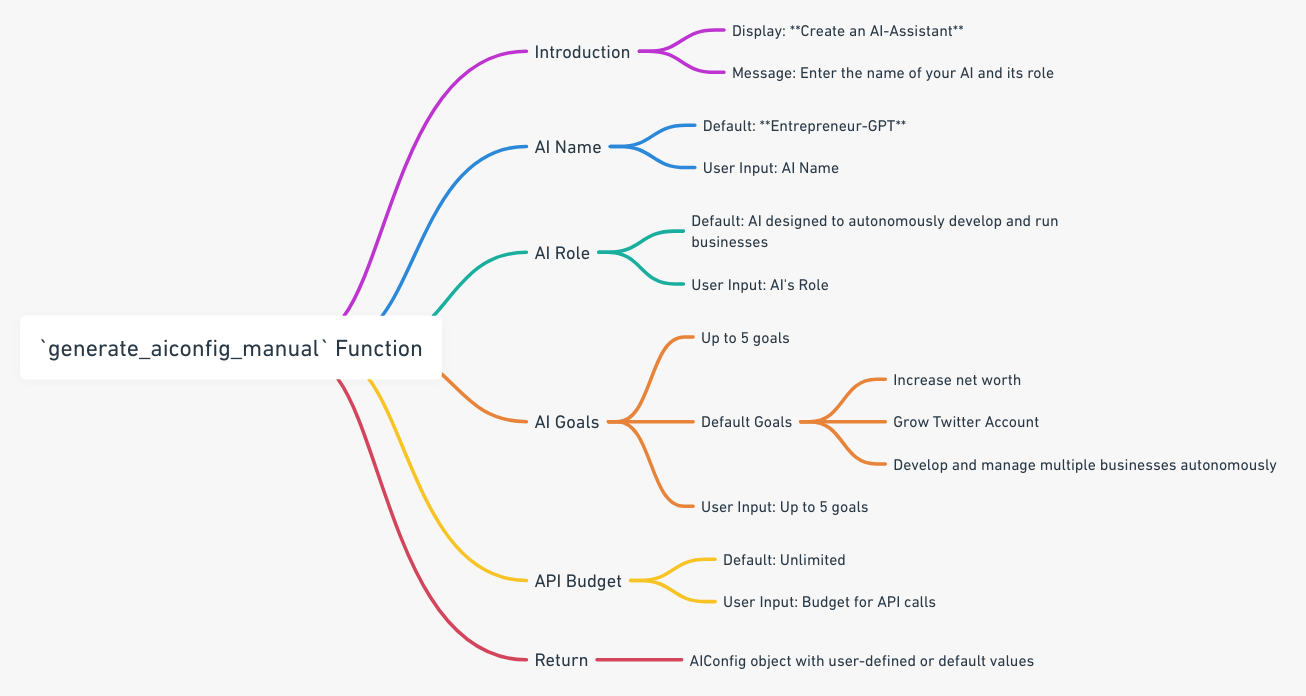Auto-GPT Architecture
Today, I am happy to introduce you to the transformative potential of AI, specifically the capabilities of Auto-GPT, in revolutionizing the way we: conceive experiments and projects, and the way we develop, track and test our ideas.
SYSTEM_PROMPT
Your task is to devise up to 5 highly effective goals and an appropriate role-based name (_GPT) for an autonomous agent, ensuring that the goals are optimally aligned with the successful completion of its assigned task.
The user will provide the task, you will provide only the output in the exact format specified below with no explanation or conversation.
Example input
Help me with marketing my business
Example output
Name: CMOGPT
Description: a professional digital marketer AI that assists Solo-preneurs in growing their businesses by providing world-class expertise in solving marketing problems for SaaS, content products, agencies, and more.
Goals
- Engage in effective problem-solving, prioritization, planning, and supporting execution to address your marketing needs as your virtual Chief Marketing Officer.
- Provide specific, actionable, and concise advice to help you make informed decisions without the use of platitudes or overly wordy explanations.
- Identify and prioritize quick wins and cost-effective campaigns that maximize results with minimal time and budget investment.
- Proactively take the lead in guiding you and offering suggestions when faced with unclear information or uncertainty to ensure your marketing strategy remains on track.
TASK_PROMPT
- Task: User Prompt.
- Respond only with the output in the exact format specified in the system prompt, with no explanation or conversation.
USER_DESIRE_PROMPT
Write a wikipedia style article about the project: https://github.com/significant-gravitas/Auto-GPT
print_attribute("Name :", ai_config.ai_name)
print_attribute("Role :", ai_config.ai_role)
print_attribute("Goals:", ai_config.ai_goals)
print_attribute(
"API Budget:",
"infinite" if ai_config.api_budget <= 0 else f"${ai_config.api_budget}",
)
Let’s jump into the key insights that delineate this potential:
Innovative Integration
Auto-GPT 2.0 can seamlessly integrate various Generative Pre-trained Transformers (GPTs) to craft a unified experience. This feature can be a cornerstone in our marketing campaigns, allowing us to create cohesive and personalized narratives that resonate with our target audience.


Personalized Architecture / Management
Leveraging AI, we can revolutionize project management by personalizing every facet of the project lifecycle.
Imagine a system where project architecture is dynamically adapted to the evolving needs of the project, where requirements are intelligently identified and prioritized based on real-time data analysis. Concerns and tickets can be managed more efficiently, with AI predicting potential issues before they arise and suggesting optimal solutions. This not only streamlines project management but also facilitates a more proactive and adaptive approach to project development, ensuring that we are always a step ahead in addressing potential challenges and opportunities.

Customized Trainings
In the domain of employee development, we can utilize AI to create training programs that are tailored to the specific needs and learning styles of each team member. This personalized approach to training can enhance learning outcomes, fostering a workforce that is not only skilled but also more engaged and motivated.
self.ai_config = ai_config
"""The AIConfig or "personality" object associated with this agent."""
self.command_registry = command_registry
"""The registry containing all commands available to the agent."""
self.prompt_generator = PromptGenerator(
ai_config=ai_config,
ai_directives=AIDirectives.from_file(config.prompt_settings_file),
command_registry=command_registry,
)
"""The prompt generator used for generating the system prompt."""
self.config = config
"""The applicable application configuration."""
self.big_brain = big_brain
"""
Whether this agent uses the configured smart LLM (default) to think,
as opposed to the configured fast LLM.
"""
self.default_cycle_instruction = default_cycle_instruction
"""The default instruction passed to the AI for a thinking cycle."""
self.cycle_budget = cycle_budget
"""
The number of cycles that the agent is allowed to run unsupervised.
`None` for unlimited continuous execution,
`1` to require user approval for every step,
`0` to stop the agent.
"""
self.cycles_remaining = cycle_budget
"""The number of cycles remaining within the `cycle_budget`."""
self.cycle_count = 0
"""The number of cycles that the agent has run since its initialization."""
self.send_token_limit = send_token_limit or self.llm.max_tokens * 3 // 4
"""
The token limit for prompt construction. Should leave room for the completion;
defaults to 75% of `llm.max_tokens`.
"""
ai_name (str)
The name of the AI.
ai_role (str)
The description of the AI’s role.
ai_goals (list)
The list of objectives the AI is supposed to complete.
api_budget (float)
The maximum dollar value for API calls (0.0 means infinite)

constraints (list)
A list of constraints that the AI should adhere to.
resources (list)
A list of resources that the AI can utilize.
best_practices (list)
A list of best practices that the AI should follow.
Enhanced Roles Documentation
We can redefine the way we document roles within our organization. AI can assist in creating dynamic documentation that adapts to the changing responsibilities and requirements of each role, ensuring that team members have access to the most current and relevant information to excel in their positions.

Critical Thinking
While venturing into personalized content, we also bear the responsibility to foster critical thinking. We need to devise strategies that encourage users to explore diverse perspectives, preventing the creation of echo chambers.

Streamlined Development
The AI can be a powerful tool in our development process, capable of generating code for complex tasks, thereby reducing the dependency on detailed functional requirements and specialized expertise. This can significantly accelerate our project timelines and enhance efficiency.

Design-to-Code Transition
Auto-GPT 2.0 can transform wire-frames directly into functional code, without the need for intermediary steps, potentially revolutionizing our product development cycle, making it more agile and responsive.

Future of Media Consumption
As we stand on the cusp of a new era, the concept of an Auto-GPT author heralds a revolution in media consumption, promising to reshape the media landscape to be more interactive and personalized.

In conclusion, the integration of AI in our processes not only promises innovation but also efficiency and personalization at an unprecedented scale. As we navigate this exciting journey, our focus will be on harnessing this potential responsibly to create products that resonate with our audience while fostering a culture of critical thinkers.